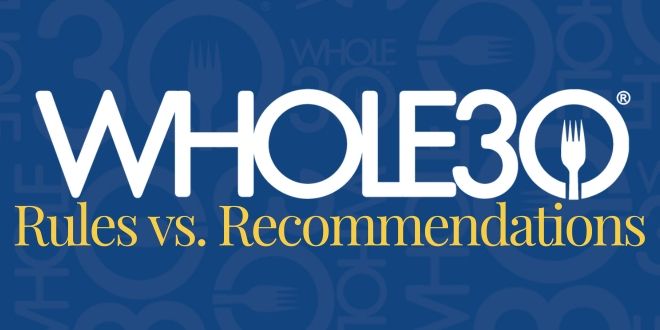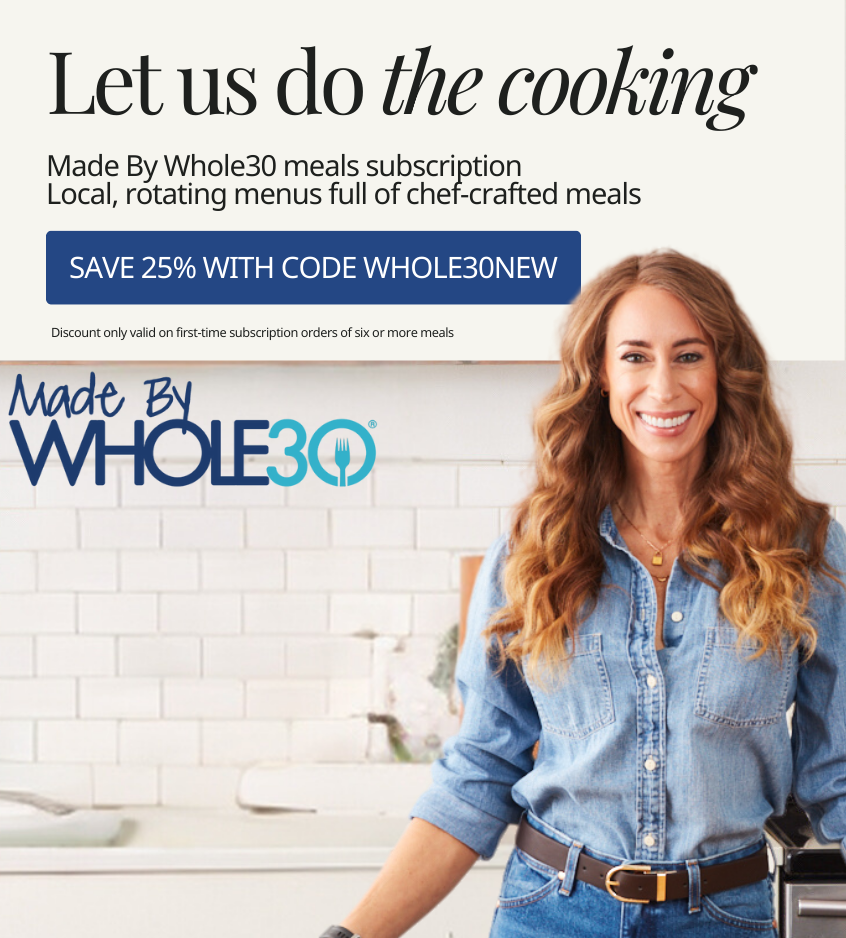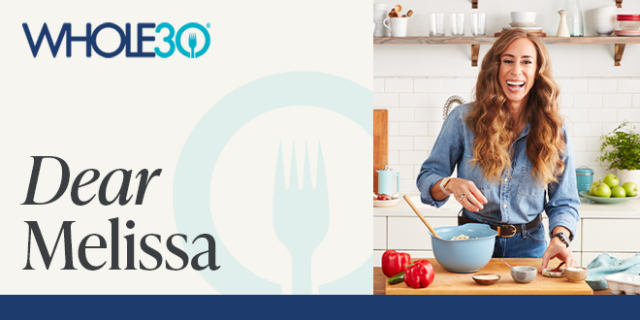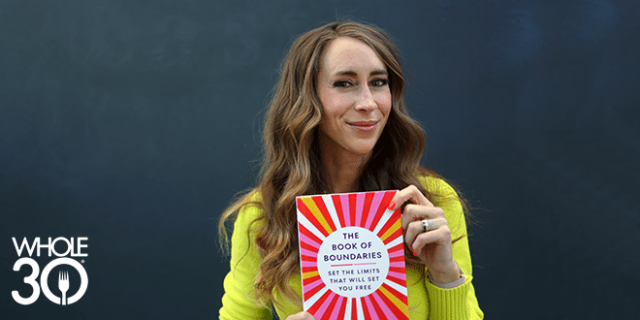There is no such thing as the perfect Whole30. We know that, and we hope you know that too. We do encourage you to follow the elimination phase rules exactly as written for 30 straight days, and complete a careful and thorough reintroduction. That’s not unique to Whole30; any elimination diet needs to be adhered to strictly to be maximally successful. And committing to all of the Whole30 Program Rules has paved the way for thousands of glowing, life-changing testimonials from alumni.
Sometimes, though, there’s so much focus put on getting it “right” that folks confuse the official Program Rules with our best-practice recommendations. In this article, you’ll read about the most commonly misunderstood rules and recommendations related to the Whole30 program. This will help you discern what to focus on with 100% dedication, and where you’ll want to use your best judgment.
For a complete and fully updated guide to the Original and Plant-Based Whole30, order our NEW flagship book, The New Whole30, available now.
The Whole30 Program Rules
Our Whole30 Program Rules (Original and Plant-Based) are your trusted source for what is (and isn’t) compatible during the elimination phase of the Whole30. They are the pillars of the Whole30 program, designed to help you achieve the life-changing results you’ve read about. The rules are detailed and specific, to help you navigate label-reading and grocery shopping with more ease and confidence.
The Program Rules for elimination and reintroduction should be followed to the letter, 100%, for the duration of each phase (unless your healthcare provider instructs you otherwise).
The Original Program Rules specify:
- No added sugar—real or artificial
- No alcohol
- No grains
- No legumes
- No dairy
- The Pancake Rule (see below)
- The Scale Rule (see below)
The Plant-Based Program Rules specify:
- No added sugar—real or artificial
- No alcohol
- No grains
- No highly-processed forms of soy
- The Pancake Rule (see below)
- The Scale Rule (see below)
Refer to the official rules for a more detailed list, and any exceptions made under the Fine Print.
The Pancake Rule
The Pancake Rule requires participants to also eliminate the following foods, even if made with Whole30-compatible ingredients:
- Bread and other baked goods: Any baked goods made from alternative flour. This includes bread, tortillas, wraps, crackers, pizza or pie crust, biscuits, pancakes, crepes, waffles, muffins, cupcakes, cookies, and brownies.
- Pasta: Any pasta or noodles made from alternative flour.
- Cereal: Any cereals made from alternative flour.
- Chips: Potato, sweet potato, tortilla, plantain, taro, or cassava chips.
- French fries: French fries (from white or sweet potatoes) or tots.
Some participants have told us, “But I don’t have a problem with (pancakes, crackers, pasta, chips)—do I still need to eliminate them?” The answer is yes! Eliminating these specific foods are part of the official Whole30 Program Rules, not just a recommendation. And this rule, more than any other, is key to effectively changing your habits and emotional relationship with food.For more on the science behind and benefits of The Pancake Rule, see this page.
The Scale Rule
One of the most unexpected (and often challenging) aspects of our program is the Scale Rule, which says “do not weigh yourself or take measurements during the 30-day elimination phase.” This is also one of the official Whole30 Program Rules, and not just a recommendation.
For 30 days, the Whole30 wants you to focus on the positive changes in your physical and mental health, the creation of new habits to manage stress, and restoring a healthy relationship with food and your body. We provide you with a huge list of non-scale victories (NSVs) to help you focus on the benefits you are seeing. And we ask that you avoid comparing your weight or measurements until your elimination phase is over—if at all.
For more on Whole30’s position on weight loss and a variety of supporting articles, see this page.
Whole30 Recommendations
Aside from the rules, we often make general Whole30 recommendations or suggest best practices. These recommendations are based on more than 15 years of experience, and are designed to help you maximize your results with the program. However, they aren’t rules, and don’t need to be followed to successfully complete the program. As such, we encourage you to use your best judgment in these areas, and do the best you can with the resources and capacity you have.
Meal template
Our dietitian-designed Whole30 meal templates can help you build a balanced Whole30 plate and ensure you’re eating enough on the program. This is especially helpful when you’re new to the program, or if the Whole30 represents a big dietary change. Our templates provide enough protein, fat, and carbohydrates to support energy, activity, mood, and focus. They encourage variation in your daily meals and snacks, to ensure a broad range of micronutrition. They also include flexibility to accommodate for your activity levels, age, muscle mass, and other factors that influence your individual calorie needs.
However, your plate doesn’t have to look like our template. Some meals may be light on veggies or protein. You may eat more snacks than full meals on long travel days. If you’re an athlete or perform manual labor, you may find your meals are much bigger, or include more healthy fats or fruit than depicted.
The template is a great guide to building your meals, but following the template exactly as written isn’t a necessity. The important thing is that all of the ingredients in your meal are Whole30-compatible.
Fruit intake
Our meal template recommends adding a serving of fruit per meal, if desired. However, that’s just a starting point, not a hard and fast mandate. We’re not concerned with the amount of sugar found in fruit, given the context of the rest of your Whole30 meals. Fruit is far more than just sugar—it also contains health-promoting fiber, water, vitamins, minerals, and phytonutrients. When consumed as part of a balanced meal containing protein and healthy fats, fruit can provide sweetness, energy, and crunch.
Eating more than three servings a day, or more than one serving per meal, is usually not problematic. In fact, this may be seasonally appropriate, if you’re doing the Whole30 during summer or fall, when fruit is ripe and plentiful. However, for those who are sensitive to the FODMAPs found in some fruits, too much in one sitting can promote digestive discomfort. If you discover this is the case, enjoy fruit in smaller serving sizes, or choose low-FODMAP fruits.
We generally recommend enjoying fruit with your meals, not on their own as a snack. Simple carbohydrates aren’t particularly satiating on their own, which means snacking on a banana or orange may not see you through until the next meal. Ideally, pair fruit with either protein, fat, or both for a more satisfying mini-meal. (See snacking.)
Snacking
Our position on snacking has evolved since the early days of Whole30. We recognize there are many reasons you might want to include a snack or mini-meal in your day. For those who have unpredictable meal times, travel for work, are active, or can only take short breaks for meals, snacks can help you support your energy and caloric needs in a way that fits your schedule.
We recommend that snacks include at least two of the three macronutrients (protein, fat, and carbs)—if not all three—for satiety. An apple by itself won’t tide you over well, and may lead to unstable energy levels or premature hunger. However, this is just a best practice, not a rule. If you’re hungry and an apple or a banana is all that’s available, by all means, eat it.
For specific snack ideas on the Original and Plant-Based Whole30, refer to The New Whole30.
Smoothies
Much like with snacking, our stance on smoothies has evolved considerably over the years. There are many reasons you may wish to incorporate a smoothie with a meal, or as a mini-meal or snack. For those with busy schedules, those who are especially active, or anyone who needs an on-the-go meal, a balanced smoothie can provide calories, protein, healthy fats, and energy.
We have yet to find a smoothie blend you can buy off the shelf that fits our Whole30 Program Rules, so you’ll have to build your smoothies yourself. Ideally, smoothies include all three macronutrients, including 15-20 grams of protein for satiety. We also recommend against making fruit-heavy smoothies, to keep blood sugar regulation and energy levels balanced. You can see our best practices for building a smoothie on the Original Whole30 here, and the Plant-Based Whole30 here. Again, these are just recommendations and not an official Whole30 Program Rule.See our Whole30 Approved lifestyle partners for compatible protein powders, from collagen peptides to single-ingredient plant proteins.
Organic, grass-fed, frozen, canned, etc.
We no longer make recommendations around purchasing organic produce, grass-fed beef, or wild-caught seafood. While there are many reasons one would choose to buy organic, grass-fed, pasture-raised, or wild-caught, nutritional benefit is not one of them. Studies have shown that the nutritional benefits of purchasing organic or grass-fed are minimal (if at all) compared to conventional versions. In addition, organic produce, grass-fed beef, and pasture-raised eggs are more expensive than conventional versions, and may not be easily accessible.
In general, we recommend choosing your Whole30 vegetables, fruit, healthy fats, and protein sources based on your access, budget, and priorities. There are no rules around food quality or dietary certifications; the only thing that matters for the Whole30 is ingredient compatibility. The same goes for purchasing fresh, frozen, or canned fruits, vegetables, and proteins. Read your labels, and buy what is accessible, budget-friendly, and suitable for the way you meal prep and cook.
Homemade everything
In 2009 (when the Whole30 first launched), compatible store-bought products like almond milk, salad dressing, ketchup, or mayonnaise didn’t exist. Today, a variety of dietary values (and the products to suit them) are becoming more prevalent. Dairy-free, gluten-free, added sugar-free products that were once only available in niche grocers are now available in Walmart, Target, and Aldi.
Whole30 offers hundreds of free recipes to create your own bone broth, salad dressing, and mayonnaise. While these homemade versions are far more budget-friendly, they are not any more “authentic” to the Whole30 than their store-bought counterparts.
We want your Whole30 to feel as easy and accessible as possible. If the ingredients in your store-bought almond milk/ketchup/mayonnaise are compatible with the Whole30 guidelines, feel free to use those products during your program. That’s what our Whole30 Approved label is all about! When you see our logo on a product, menu, or website, you know the product listed is automatically compatible with the Whole30 program rules—no label-reading required.
Visit our Whole30 Approved partner page and discover hundreds of guaranteed-compatible foods, beverages, supplements, and meals
Cooking oils
The New Whole30 features a rule change that no longer eliminates any cooking oils from the program, regardless of the source. This means you are free to cook with a variety of oils, like extra-virgin olive oil, coconut oil, cultured oil, canola oil, or sunflower oil. This helps make the program more accessible, allowing you to cook or make dressings with the oils that are easy to find and suit your budget.
There are pros and cons to using various cooking oils for various tasks. Some oils have higher smoke points, which makes them better for high-heat cooking. Other oils are higher in heart-healthy monounsaturated fats. Still others have a neutral flavor, making them a good base for homemade mayo or salad dressings. In general, we recommend using seed oils (like safflower, sunflower, soybean, or corn oil) at lower temperatures and not reheating them, to preserve their nutritional integrity and flavor. Sourcing cold-pressed, unrefined, or high-oleic oils can also help boost their antioxidant and/or monounsaturated fat content.
Starting over on the elimination phase
The Whole30 program guidelines ask you to follow all of the Program Rules for 30 straight days during the elimination phase. We also suggest if you deviate from these rules, you start your elimination phase over from Day 1. This isn’t unique to Whole30; all elimination diets feature strict rules to be followed for several weeks at a time. It often takes at least 30 days of consistently eliminating potentially problematic foods to understand if they’re causing symptoms. If you are sensitive to any of the foods we ask you to eliminate, including them here and there throughout the 30 days can interrupt that healing process, and negate the potential benefits.
Still, if you missed an ingredient on a label, gave in to peer pressure, or were accidentally served something with dairy or gluten, do you have to start over? We’d strongly encourage you to, yes. And also, you’re an adult who can make your own best decision. The Whole30 is designed to promote better physical and mental health, and we want you to commit to the program 100%. But if starting over for an error you had nothing to do with would set you back mentally or make finishing the program impossible, we trust you to make the right decision for you.
Rules vs. recommendations
Our best advice here? Commit to the program, and yourself, 100%. Get familiar with our official Program Rules. Take the time to read that label twice. Stay off the scale (it’s not worth it). Look for non-scale victories along the way—they all count. And be immensely proud of yourself for taking on something as hard and life-changing as the Whole30. With few exceptions, you’ll get back as much as you put into it.

















